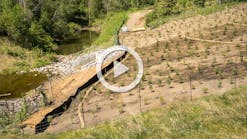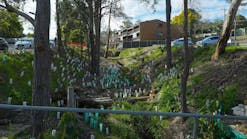Cofferdams and turbidity curtains may be neither high tech in performance nor especially exciting in appearance. If they’re made carefully and function the way they are supposed to, they seem, in fact, rather routine. But the work that they make possible is far from routine. They make possible high-tech projects in energy, construction, and other fields. They protect endangered flora and fauna and help companies stay in compliance with federal, state, and local environmental regulations.
Treasure Hunt
Cofferdams are usually deployed to make construction or repair projects possible by temporarily holding back bodies of water so that work sites are accessible. Such projects typically involve pipelines, bridges, roads, marinas, and other structures—not buried treasure.
But cofferdams played an important role in one particular hunt for buried treasure.
And since this treasure hunt has been turned into a reality television series, millions of people around the world who had never heard of cofferdams now know what they are and how they work.
When they were boys, brothers Marty and Rick Lagina of Kingsford, MI, read an article about buried treasure in the January 1965 issue of Reader’s Digest. They were fascinated by the story of previous attempts to find this treasure that many people thought was real, and their interest continued as they became adults.
The Lagina brothers became convinced from historical evidence that the treasure was buried on Oak Island, off the coast of Nova Scotia. They had been quietly searching for the treasure there for several years when Prometheus Entertainment learned of their quest.
Based in Los Angeles, CA, Prometheus is the production company responsible for such popular television productions as Ancient Aliens, The Girls Next Door, and Star Wars: The Legacy. A series that let viewers follow along with real treasure hunters was different for Prometheus, but the concept had built-in suspense and it fit the company’s overall approach to selecting entertainment.
Prometheus Entertainment’s Joe Lessard says, “We’re always looking for a good story.”
The Lagina brothers owned the search operation on Smith Island. “We were begging them to meet with us, but they were reluctant to be on TV,” says Lessard. “Finally we came to a cooperative agreement. They realized that being on TV would connect them to resources, financial and otherwise.”
The resulting collaboration between the Lagina brothers and Prometheus is the series The Curse of Oak Island, for which Lessard serves as executive producer. Now in its fifth season on cable television’s The History Channel, the popular series attracts viewers in many countries.
The first episode aired on January 5, 2014, and ratings were strong from the beginning.
Viewers were immediately drawn into the story by the little twists and turns within each episode and the overall tantalizing theme of getting closer and closer to the buried treasure.
Each episode might be the one that showed the Lagina brothers finding the treasure at last, after years of hard work. Because some previous treasure hunters had died in a tragic accident, the possibility that a curse had been placed on the treasure to protect it was another part of the puzzle for viewers of the series to ponder.
The series includes interviews with historians and others who have developed theories about the buried treasure. Assorted theories and possible connections include North African gold, a French map dated 1347, visits from ancient mariners, codes hidden in Shakespeare’s writings, Sir Francis Bacon and the Rosicrucians, the Aztec Empire, and the Knights Templar.
As the exploration continued and episodes were filmed and aired, various clues suggested that it would be worthwhile to examine the area of Oak Island that curved around a section known as Smith’s Cove. But to either find the treasure there or rule out the location definitively, a thorough digging operation with machines was essential.
Before the digging could begin, Smith’s Cove had to be dewatered. Dam-It Dams of Brighton, MI, was tasked with supplying and installing the cofferdam to dewater the area and keep it dry enough for digging 6 to 10 feet down.
Two cofferdams were connected to make a barrier around the cove. Each cofferdam was 200 feet long. The installation took place in August 2016. After the water was pumped out, the team could then excavate the rocky cove. The search area was about 9,000 square feet.
Lessard says the cofferdam “went up really quickly, and it worked really well. Day in and day out, as the tide came in, the pump worked and the dam held the water out.”
The cofferdam was about 8 feet above the deepest spot in the cove. The weather was good, with cool temperatures during the excavation. One man operated the excavator, digging down 6 to 10 feet. Five to ten people observed the work and took notes. One observer was the show’s consulting archaeologist.
Lessard says the biggest challenge to the excavation in Smith’s Cove was that the ground was “muddy, hard, and rocky.”
Clues from previous excavations and research led the Lagina brothers to suspect that they would unearth five ancient box drains buried in Smith’s Cove. The box drains were shaped like a hand converging on the shoreline and leading to a big pit that flooded with seawater. Lessard says although they did not find the box drains, they did find French drains. Those drains might lead to another, even more specific, clue—or not—but it was one more piece of what has proven to be a big puzzle. Each object unearthed has to be logged and its history verified.
“The cofferdam helped make this search possible,” he says, adding that using a Dam-It Dams cofferdam again on the show “is a possibility. It is a useful resource for searching other parts of the island. We have explored about 60% of the island, and no area of it can be ruled out [without checking it thoroughly].”
The episode featuring the cofferdam at work on Smith’s Cove aired in the fourth season (November 16, 2016, to February 21, 2017).
Excavating around the Fisherman’s Park boat ramp
Rescuing a Boat Ramp
Bastrop, TX (2010 population 7,218), is part of the Austin metropolitan area. The city lies on both sides of the lower Colorado River, which is approximately 100 yards wide. With such close proximity to the river, boating is a popular recreational activity with Bastrop’s residents. One of the most convenient ramps for launching boats in Bastrop was built several years ago in the city’s Fisherman’s Park.
“Different floods deposited large amounts of sand around this boat ramp,” says David Junek, superintendent of parks and recreation for the city’s Public Works Department. “An existing sandbar nearby was also encroaching the ramp.”
The sand lowered the level of the river around the ramp, making it too shallow to launch a boat without scraping its bottom. Bastrop’s Public Works Department members knew that the sand would have to be removed and the area surrounding the ramp dug out so that the river was back to its normal depth.
Junek says city workers “pumped out the water, scraped off the sand covering the boat ramp, and dug out the sand about four feet around the three sides of the ramp to make the river there deep enough to put in a boat.”
The major required permit, which was good for five years, was obtained in 2015. The project had been planned for 2016, but had to be delayed a year. Junek says the citizens were patient because they knew the city employees would get the boat ramp back into service as soon as possible.
With the necessary federal, state, and Lower Colorado River Authority permits, funding, and plans in place, work on the project started on November 6, 2017. The work was finished and the boat ramp ready for use about three weeks later.
An essential part of the project was dewatering the area around the boat ramp so that the workers and their machines would have clear access to the site. The dewatering was done by installing a cofferdam made by Aqua Dam of Scotia, CA.
The cofferdam was 345 feet long and six feet wide. “The six-foot-tall dam was good for the four-foot depth of the river,” says Junek. The cofferdam was deployed in about 12 hours.
Aqua Dam sent company employees to Bastrop to teach the city’s crew members how to install and maintain the cofferdam. “All of the work was done by Aqua Dam with our city employees. This was a brand new project for us. The boat ramp had been cleaned some years before, but it was new work for all of the current employees,” says Junek. “The company was very helpful, pointing us in the right direction all the way. I can’t praise them enough. There is some pressure when you’re spending city money. You want to make sure you get it done right the first time.”
He says the major challenge on the project was “keeping the water pumped out. The sand is very porous, so water can seep back in quickly.”
The crew had two options to keep the work area dry. They could either leave the pumps running constantly, or turn them off at the end of their shift and pump out the water that accumulated overnight. To save energy costs, “We chose to come in early every morning and re-pump the water out,” says Junek. “It took only about an hour and a half.”
The weather was good while the work was going on. “We got a little bit of rain, but it wasn’t a problem,” he recalls.
The project attracted an interested audience of local residents. “We had several people park and watch the work. They were traveling on a bridge that goes over the Colorado River, a major thoroughfare that connects major highways, when they saw the crew at work. They parked and came back to check it.”
The work required excavators, front-end loaders, and other machines. All of that heavy equipment attracted kids, too, and when they saw the cofferdam, some of them asked if they could go over and jump on it.
The project involved a lot of digging. Junek says he was surprised, though, at how quickly it was done. “I thought it would take us a month,” he says.
In a few years, the Colorado River will redeposit sand around the boat ramp. The project to remove the sand and allow the water around the ramp to flow freely will have to be repeated. The Bastrop crew is prepared for that future work and expects it to go faster the next time.
“We purchased the cofferdam, so we can reuse it,” says Junek.








